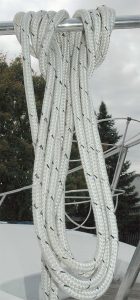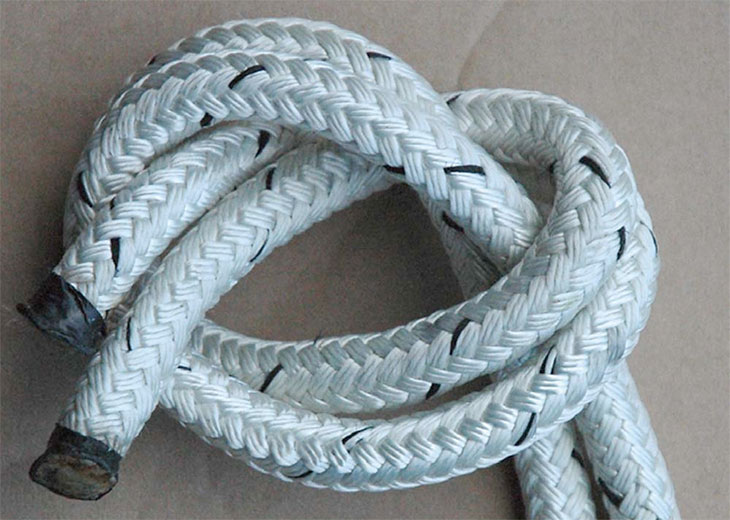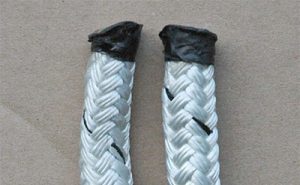originally posted Tuesday, 01 January 2013
By Mark King
Untangling onboard and on the dock
Modern technology has changed a great many items for recreational boaters over the past several decades. Our engines have moved from gas guzzling, exhaust spewing, carburetted behemoths to fuel sipping, lightweight, electronic, fuel injected machines of refinement and elegance. On board electronics have taken navigation and communication out of the classroom and into the living room where we can now spend an evening reading the instruction manual instead of a season learning formulas and sight tables. Creature comforts on a boat used to mean having a head and maybe a shower. Now it is comfy chairs, settees and full size berths and bath tubs.
But one area where little has changed and operator skill is still required is in the knowledge and handling of lines on board our boats. Yes, the substance of lines has changed as synthetic has replaced natural fibres in most cases, and yes we can now purchase lines in bags, cut to length complete with cleat loops and splices. But, the actual use and handling of lines has not changed much and probably will not change much in the foreseeable future.
 A neat and safe way to stow lines that are not in use and while underway. If you are expecting bad weather you can wrap a Velcro strip around the line where it circles the rail.
A neat and safe way to stow lines that are not in use and while underway. If you are expecting bad weather you can wrap a Velcro strip around the line where it circles the rail.Why do we need to think about line handling on board a boat?
The answer is simple. We learn about proper line handling techniques so that we never have to watch someone fall overboard with a line coiled around their leg. So that we never have to hear the sickening “thunk” of a propeller being torn free by a line that fell overboard but remained tied to the stern cleat. And so we never arrive at the marina to discover that our boat has drifted downstream because it wasn’t secured properly to the dock.
Let’s start with some basic definitions. Rope, which comes in coils, is called line when it has been sized and spliced for use on board our boat. Throughout this column then we shall refer to lines.
You can create your own lines out of standard three-strand rope or braid line simply by purchasing coils of whichever one you wish to use and then cutting them to length. You must then splice or whip the ends so that they do not come apart. This way you get the exact length of line that you want. The disadvantage is that you need to finish off the ends so that they don’t slowly unravel. From using the proper tools and splicing or whipping, to using the commonly referred to “butane back splice” where heat is applied to melt and fuse the ends of the lines, there are several techniques that can accomplish this task. There are many books available on rope and line techniques that you can purchase and follow to make your own perfect lines. The other option is to purchase pre-packaged lines. They come spliced and can have cleat loops making them easy to attach to the boat cleats.
Whichever way you decide to outfit your boat, there is one rule you should always follow. Make sure that any line attached to the boat, if it falls overboard while still attached to the boat, will not reach the propeller.
It happens more often than you might think. How many times have you seen someone cruising past with a line hanging in the water? As a rule of thumb, the bow line can be long, mid-ship lines long enough to reach the bow and stern without reaching the propeller, and the stern lines just long enough to safely tie to a dock cleat.
It is always wise to have a few extra lines on board so you don’t have to switch lines from side to side and in case you need lengthen a line in a hurry. These should be stored in an easily accessible location but safely tucked away where they cannot accidently be kicked overboard.Lines to hold fenders should be just long enough to tie the fenders and allow enough slack for possible adjustment for changing dock heights. If they fall overboard, the lines attached to them shouldn’t be long enough to foul the propeller.
On deck, either at dock or underway, lines should be stowed so that they are not loose. You can either remove them from their cleats when they are not in use and stow them securely out of the way, or you can use a hanger or some other method to get them up off the decks.
Lines that are loose on any deck are dangerous. People moving around the boat can easily become tangled in them, or lose their footing as the line rolls under their feet. They are also unsightly attracting bugs and dirt.
Anchor lines are another story. As well as using the proper technique for setting and retrieving your anchor, you should have a secure place to stow anchor rode (line). Most modern boats have a specific anchor locker where the rode goes when it is not in use.
If not, you can use a bucket or similar container with a secure lid and a hole cut in the top to feed line in and let it out. Ensure this bucket or container is held securely in its location on the boat.
Piling anchor rode on deck while hauling in an anchor is a recipe for disaster afloat. Even under ideal conditions you can become entangled, or slip on the wet rode as it rolls under foot. And, as has been pointed out repeatedly, it is in emergencies that we stop paying close attention to the rules and stop thinking about the problems that we might be creating while we are in a hurry to solve another issue.
As mentioned earlier in this column, there are many books available that will teach you proper knots. You really only need to know a few knots to be a proficient boater.
The figure eight “stopper” knot, the bowline, which is easily broken even after months of use, and proper techniques to tie to a dock cleat, as well as a dock post or bollard are the most important.
A quick and easy way to join to lines together to make a longer line when required is also a handy knot to know. There are fancy ones but in an emergency, simply tying the ropes together in a stopper knot works and is also easily broken when you are finished.
The final place you want to be concerned about your lines is when you are tied to the dock. After securing the boat properly make sure that the loose ends are not littering the docks. Either tie them back up to the boat, tie them off on themselves, or use a Flemish coil to lay them neatly on the dock.
You will not only be protecting yourself, you will be protecting everyone who uses the dock.


